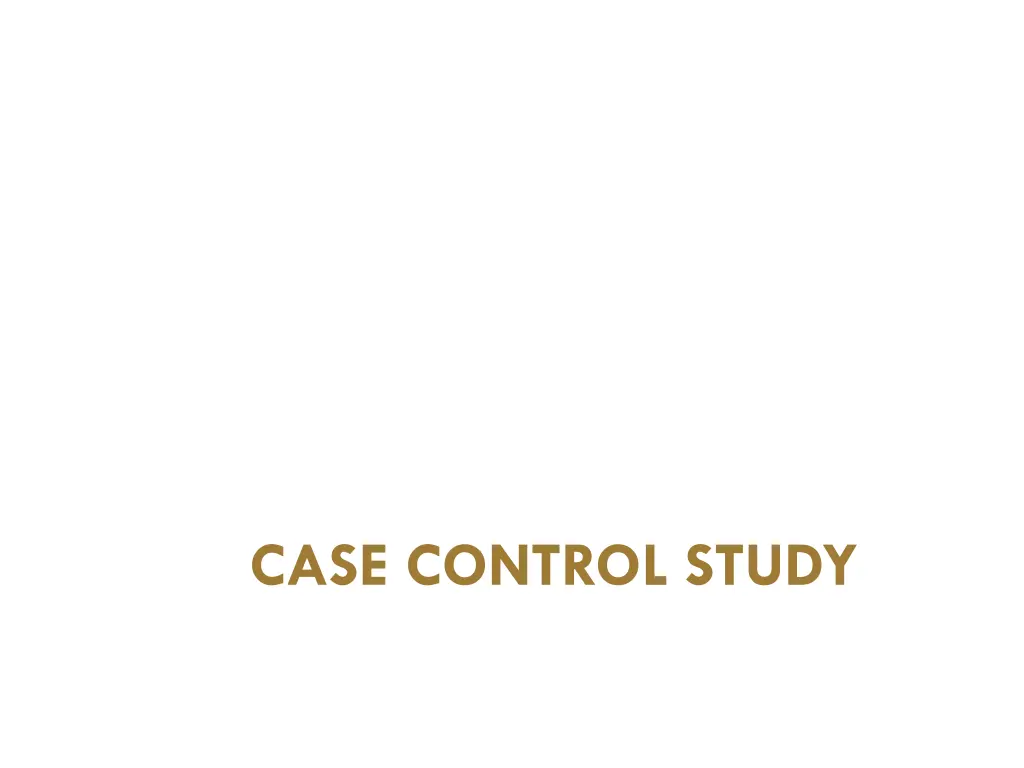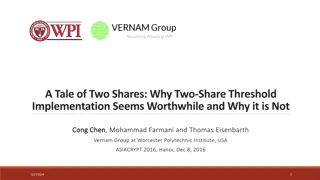
Understanding Case-Control Studies in Epidemiology
Explore the principles, advantages, limitations, and implementation of case-control studies in epidemiology. Learn how to design, analyze data, and interpret findings in this research methodology used to identify risk factors for health problems.
Download Presentation

Please find below an Image/Link to download the presentation.
The content on the website is provided AS IS for your information and personal use only. It may not be sold, licensed, or shared on other websites without obtaining consent from the author. If you encounter any issues during the download, it is possible that the publisher has removed the file from their server.
You are allowed to download the files provided on this website for personal or commercial use, subject to the condition that they are used lawfully. All files are the property of their respective owners.
The content on the website is provided AS IS for your information and personal use only. It may not be sold, licensed, or shared on other websites without obtaining consent from the author.
E N D
Presentation Transcript
Learning Objectives Identify the principles of case control design State the advantages and limitations of case control study Calculate the sample size for a case control study (Epi program) Identify the characteristics of cases that will be selected Identify the characteristics of the controls that will be selected Discuss the issue of matching in case control study State the source of bias in a case control study Analyze data from a case control study Identify the repercussion of the limitations on the interpretation of the findings
Performance objectives Design and implement a case control study and interpretation of the findings Estimate the sample size required for a case control study 1. 2.
PRINCIPLE OF CASE CONTROL STUDY Selection of individuals on the basis of having the disease (cases) and not having the disease (controls)and comparing them in respect to the presence of risk factors.
DEFINITION OF CASE CONTROL STUDY Analytic research design used for testing a hypothesis regarding a particular health problem and single or multiple exposures. Starts with the outcome (health problem) then look backward for the exposure to identify potential risk or protective factors. Provide answer or an explanation about why one group of people is affected and not the other.
PROCEDURE OF IMPLEMENTATION Define objectives and research questions 1. Determine the cases for a case control study 2. Determine the controls for a case control study 3. Decide on the ratio of cases to control 4. Decide on matching cases and controls 5. Estimation of the sample size 6. Select cases and controls 7. Obtain data on exposures 8. Analyze and interpret the findings 9.
OBJECTIVES AND RESEARCH QUESTIONS The overall aim is to identify and quantify the risk factor(s) associated with the occurrence of a health problem Research question what are the risk factors associated with the occurrence of a health problem? or is the rate of exposure to a particular factor differ between cases and control? Aim : identifying predictors of a health problem
DETERMINE WHO IS THE CASE Establish a standard case definition Adopt a standard diagnostic criteria Set inclusion and exclusion criteria Decide on the type of cases (incident or prevalent cases) Incident cases reflect the determinant of the disease Prevalent cases reflect the determinant and disease duration
DETERMINE WHO IS THE CONTROL The ideal controls are the healthy however Enroll controls who are by definition sick yet with specifying conditions of inclusion Free from the health problem under investigation Free from health problems known to be associated with the exposure Being comparable to cases in terms of susceptibility
DECIDE ON CASE CONTROL RATIO The ratio of cases to control should be at least 1:1 Increase in the ratio lead to increase in study precision 1:2 1:3 1:4 Further increase is associated with little increase in study precision relative to the cost involved
MATCHING IN CASE CONTROL STUDY Matching reduce the possible confounding effect Matching on several characteristics is not advisable as it Creates difficulties in finding controls Requires more complex statistical analysis May result in overmatching Matching design should be followed by matched analysis Few statistical programs provide opportunities for matched analysis as STATA and SAS.
SAMPLE SIZE ESTIMATION www.openepi.com
Two side confidence level Power of the test Ratio of cases to control Percent of controls exposed Then one of the followings Odds ratio Percent of cases exposed
SELECTION OF CASES AND CONTROL Ensure that cases are representative Identifying cases through registries and records of health facilities to represent cases in the community Or/ Enroll those meeting the diagnostic criteria from those attending a specific health facility
SELECTION OF CASES AND CONTROL Selection of healthy controls implies the selection of controls from healthy subjects in the general population Or/ Select controls meeting the inclusion criteria from those attending the same health facility attended by the cases. Lower cost and time Higher participation rate (minimize non-response) Tend to recall past events better (minimize recall bias) Tend to have over presentation of risk factors Difficult in determining which appropriate illness for inclusion Control could be relatives and neighbors as they are comparable to cases in respect to a large number of exposures
OBTAINING DATA ON EXPOSURE Asking questions of relevance to the exposure using Self administered questionnaire Interviewing participants either face to face or by telephone Review of medical or employment records More than one source of information can be use to complement each others In deciding on the source one should consider availability, accuracy as well as the logistics and cost of data collection.
ANALYSIS OF CASE CONTROL STUDY (25) (100) (20) (200) 1818
QUANTIFICATION OF RISK Exposure Disease status Case Control Exposed 25 (a) 20 (b) Not exposed 75 (c) 180 (d) Total 100 (a+c) 200 (b+d) Rate of exposure among cases = (a/a+c) x constant (25/100) X 100 = 25% Rate of exposure among controls= (b/b+d) x constant (20/200) X 100 = 10% Odds ratio (OR) = (axd)/(cxb) (25x180)/(20x75)= 3.0 19 19
QUANTIFICATION OF RISK Exposure Disease status Case Control Exposed 25 (a) 20 (b) Not exposed 75 (c) 180 (d) Total 100 (a+c) 200 (b+d) Odds ratio (OR) = (axd)/(cxb) (25x180)/(20x75)= 3.0 Odds of exposure among cases= (a/a+c) a ---------- = --- (c/a+c) c Odds of exposure among controls= (b/b+d) b ----------- = --- (d/b+d) d Odds ratio= (b/d) cb (a/c) -------- = ----- ad 2020
INTERPRETATION OF ODDS RATIO Exposure Disease status Case Control Exposed 25 (a) 20 (b) Not exposed 75 (c) 180 (d) Total 100 (a+c) 200 (b+d) Odds ratio (OR) = (axd)/(cxb) (25x180)/(20x75)= 3.0 Odds of exposure among cases= Odds of exposure among controls= Odds ratio= (a/a+c) a ---------- = --- Interpretation of OR (c/a+c) c (b/b+d) b ----------- = --- (a/c) -------- = ----- < 1 =1 >1 Protective Not related Risk (d/b+d) d ad (b/d) cb 21 21
ELABORATION ON ODDS RATIO OR > 1 Percentage increase of disease as a result of exposure [(OR 1) * 100] OR < 1 Percentage decrease of disease as a result of exposure [(1 OR) * 100] 22
Utilities Study of rare diseases Study of diseases with long latency period Evaluate all possible factors associated with the disease Quantification of the risk associated with exposure (s) Save cost and time 23
Limitations No value in the study of rare exposure Cases don t represent cases in the general population Selection bias Recall bias Inability to define the temporal sequence between the disease and the exposure Not for study of several diseases associated with a single exposure 24





















